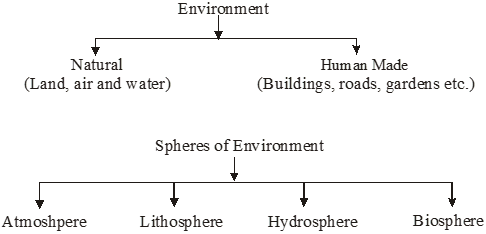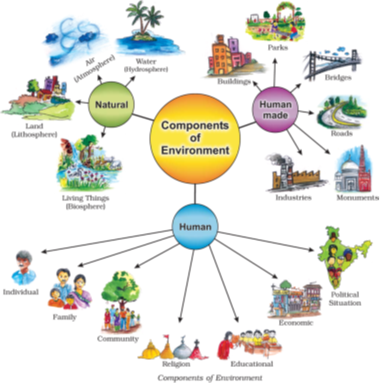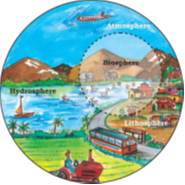- Books Name
- CBSE Class 7 Social Science Book
- Publication
- Param Publication
- Course
- CBSE Class 7
- Subject
- Social Science
* INTRODUCTION :
![]()

* WHAT IS ENVIRONMENT?
Literally, environment means surroundings or conditions under which a person or a thing exists and develops his/its characteristics. For example, the environment of a plant refers to all those conditions which help the growth of that particular plant. Like soil, rainfall, temperature etc.
Environment is combination of natural environment and human made phenomena. 
The natural environment refers to both biotic and abiotic conditions existing on the earth.
Biotic: The world of living organisms. E.g. plants and animals.
Abiotic: The world of non-living element. E.g. land.
Human Environment reveals the activities creations and interactions among human beings.
* NATURAL ENVIRONMENT
Land, water, air, plants and animals comprise the natural environment.
* MAJOR SPHERES OF ENVIRONMENT
The major spheres of environment are the following :
(i) Atmosphere (ii) Lithosphere (iii) Hydrosphere (iv) Biosphere.

* ATMOSPHERE
The air-envelope that surrounds the earth is called the atmosphere. It is a mixture of many gases such as nitrogen, oxygen, argon, carbon-dioxide etc. It also contains water vapour, dust and smoke particles. It is to be remembered that the atmosphere extends a little beyond 1,600 kilometres from the earth.
Importance of the Atmosphere
The atmosphere is very important to us. It has many advantages of its own :
(1) The atmosphere acts like a blanket or a glass house for the earth. It receives the radiation of the sun but does not allow the insulation to escape. As such it keeps the earth warm.
(2) Water-vapours and carbon-dioxide present in the lower layers of the atmosphere absorb the heat radiated by the earth’s surface and keep the atmosphere warm even during night.
(3) The changes in the atmosphere produce changes in the weather and climate.
* LITHOSPHERE
Another important sphere of the environment is the lithosphere which envelopes its interior portion. The average thickness of the lithosphere comes to be about 100 kilometres.
It has been found that the thickness of the earth’s crust is greater where the continents exist as compared to the ocean floors.
Importance of The Lithosphere
The outer covering or crust of the earth, which is called lithosphere, is of great importance to us.
Its soil cover is indispensable for the growth of plants. Moreover, lithosphere is a source of various mineral resources including those of coal and oil.
The various landforms of the lithosphere can be put to various uses depending upon the economic factors and human needs.
* HYDROSPHERE
Those parts of the earth which are covered by water form the hydrosphere. The oceans, lakes, rivers and other water bodies on the earth form the hydrosphere. About 71% of the earth’s surface is covered with water; so the earth is sometimes called a watery planet. Moreover, the earth is the only planet which has water.
* BIOSPHERE
Life on earth exists in a narrow belt, a little below and above the surface of the land and in water and air. This narrow belt of living organisms, both plants and animals, is called biosphere. This sphere thus includes parts of atmosphere, lithosphere and hydrosphere.
* WHAT IS ECOSYSTEM?
1. Ecosystem it is a system formed by the interaction of all living organisms with each other and with the physical and chemical factors of the environment in which they live, all linked by transfer of energy and material.
2. All plants, animals and human beings depend on their immediate surroundings. Often they are also interdependent on each other.
3. This relation between the living organisms, as well as the relation between the organisms and their surroundings forms an ecosystem.
4. There could be an ecosystem of large rain forest grassland, desert, mountains, lake, river, ocean and even a small pond.
* HUMAN ENVIRONMENT
1. Human beings interact with the environment and modify it according to their need. They led a simple life and fulfilled their requirements from the nature around them. With time, needs grew and became more varied. Humans learn new ways to issue utilise/see and change environment.
2. They learn to grow crops, domesticate animals and lead a settled life. The wheel was invented, surplus food was produced, barter system emerged, trade started and commerce developed. Industrial revolution enabled large scale production. Transportation became faster.
3. Information revolution made communication easier and speedy across the world.
4. A perfect balance is necessary between the natural and the human environment. Humans must learn to live and use their environment in a harmonious way.
* WHY IS EARTH CONSIDERED A UNIQUE PLANET?
The Earth is considered to be a unique planet in the solar system due to the following factors:
1. The distance of the earth from the sun results in such a climate which is best suited for the development of man and other forms of life on the earth.
2. Its atmosphere is rich in oxygen that makes life possible on this planet. It acts as a large cover to protect its surface from extreme cold and heat.
3. On earth, water occurs in cost abundance quantities which makes life possible on the earth, as water is essential for all forms of life.
* GLOSSARY
Environment : The external conditions in which an organism lives.
Physical environment : All the abiotic component of environment like the lithosphere,the atmosphere and the hydrosphere.
Atmosphere : The thin layer of air which envelopes our earth.
Lithosphere : Layer of the earth comprising rock materials, extending to continents and ocean basins.
Hydrosphere : Part of the earth’s surface covered with water.
Biosphere : A very narrow sphere of the earth which sustains life.
Illustration 1
Write difference between biotic and abiotic environment.
Solution

Illustration 2
Difference between Natural and Human made environment.
Solution

Illustration 3
Distinguish between Hydrosphere and Atmosphere.
Solution


 Param Publication
Param Publication
